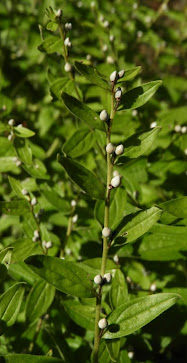This will be the last blog for a while as I am largely seeing only what I have already focused upon.
It seems appropriate that by chance it will cover two species that despite their names are not particularly common and in the case of Common Calamint declining.
- Common Gromwell, Lithospermum officinale
- Common Calamint, Clinopodium ascendens
Common Gromwell
I found this by chance at the end of a walk in the Cannop area of the Forest of Dean. I only saw the one plant and knew I'd not seen it before, but luckily from the similarity of the one flower to a Forget-me-not and therefore the Boraginaceae family, identified it from Simon Harrap's Wild Flowers. Thanks to the #Wildflowerhour community on Twitter for confirming it.
It grows in some southern parts of the UK but is less common elsewhere. It is native to Europe and Eastern Asia and has been introduced to other regions including North America.
The cream flower is so small it is a key ID feature. The plant is tall, hairy, with alternate, narrow and spear-shaped leaves. The veins are conspicuous.
A few days later after heavy rain I went back hoping to find a colony and I did. Over 400 metres or so of the open woodland ride there are many plants. There were thousands of seeds which bodes well for the future here.
The 5 narrow sepal teeth clasp around the fruits. Sepals have longish hairs on the outside. The hard egg-shaped fruits change colour as they mature, the shiny white like porcelain being the last stage.
The rather mysterious name comes from the Old French gromil, modern French grémil. The gré suggested grey and the fruits themselves grains of mil or millet. Gromwell also came known as milium solis, 'millet of the sun'. It grows here on a largely cleared woodland hillside in full sun.
Its local name in the north of England, Stony-hard, reflects its herbal medicine use in the sixteenth and seventeenth century against stones. It may have been the lithospermon or 'stone-seed' of Dioscorides and indeed can be called European Stoneseed. It has been used widely, for example against gout, as a diuretic and as a contraceptive.
Common Calamint
I first found this hairy herb from the Lamiaceae family in the Forest of Dean Cannop area last year and returned hoping to find it again. I think it had increased at the top of the spoil heap, a dry area that suits it well. Again thanks to the #Wildflowerhour expert who agreed the ID.
The flowers are whitish-pink with small purple spots on the lower lip. The leaves, with shallow and blunt teeth, are short-stalked with curved veins and smell distinctly of mint. The upper lip of the corolla is flattish and has a notch at the top. The lower lip is short and three-lobed. There are four stamens, two unequal stigmas and one style.
The calyx has five teeth, the lower two are slightly longer and narrower. I hope that can be seen here along with the hairs.
It was a very windy day so I took a tiny piece for macro pics at home leaving plenty behind. It is a plant that is decreasing in its range. The reasons include lack of control in its grassland habitats and changes in road verge management. However, it is now better recorded particularly in East Anglia and Somerset.
It is native to temperate areas of Europe and used as a culinary herb in Italy. In Madeira, where it is known locally as neveda, it is used as a mouth freshener and to alleviate headache and toothache. It was known to Culpepper who writes of its usefulness in easing brain afflictions, leprosy, convulsions, cramp and yellow jaundice.
Acknowledgements
Simon Harrap's Wildflowers
Stace 4
Rose The Wild Flower Key
Grigson The Englishman's Flora
www.researchgate.net/
www.brc.ac.uk/
www.wildflowerfinder.org.uk/
www.wildflowerweb.co.uk/
www.geograph.org.uk/
www.first-nature.com/










No comments:
Post a Comment